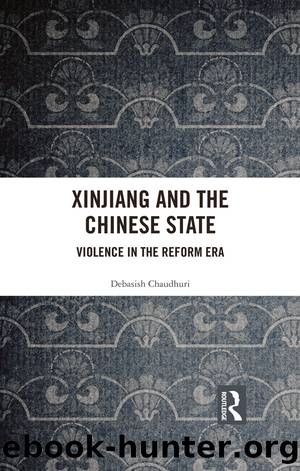Xinjiang and the Chinese State by Debasish Chaudhuri

Author:Debasish Chaudhuri [Chaudhuri, Debasish]
Language: eng
Format: epub
ISBN: 9781138063051
Barnesnoble:
Publisher: Taylor & Francis
Published: 2017-08-24T00:00:00+00:00
Ethnic violence 1990â2001
In the uneasy political atmosphere after the Tianâanmen Square incident, the central Chinese authorities left no room for dissent anywhere in China let alone a minority region like Xinjiang. The government took a more ruthless attitude in implementing its policy towards the minority region. The accommodative policies of the early reform period in religious and cultural matters were replaced by strict control and biased policies. The construction of new mosques was halted and many religious schools were closed. The new regulations restricted meetings between the Muslim clerics of the region and foreigners. The authority forbade teaching of sensitive subjects like the Uyghur history and greater restrictions were imposed to curb research activities on Xinjiang. Religious teachers from Muslim countries were no more allowed to work in the Xinjiang Theological Seminary in Urumqi which was opened with Saudi funding in 1987 and the seminary officials discontinued all ties with Egyptâs Al Azhar University. The minimum age of the haj applicant was restricted to 50 years, and throughout 1989, a number of regulations were imposed to check the increasing contacts between the Muslims of Xinjiang and other parts of the world (Harris 1993a: 121). During 1989 and 1990, with the collapse of the communist states of Eastern Europe and the breakdown of the Soviet Union, the atmosphere in Xinjiang grew tenser. The decline of the communist world since 1989 forced China to impose further restrictions in the region to safeguard itself from real as well as perceived domestic and international threats. In the high tide of economic reforms, regional, interethnic and intra-regional economic inequalities, manipulative propaganda and coercion have considerably reduced trust among the ethnic Uyghur and Han population in Xinjiang. In this situation, the Uyghur separatist movement began to take a violent turn and fundamentalist forces began to enter the political scene of the region.
In consequence of the restrictions on religious matters in the region, the first major anti-Chinese riots broke out in Baren Township, Akto County, in the Kizilsu Kyrgyz Autonomous Prefecture in the southwestern fringe of XUAR on 5 April 1990. In the early reform period, Baren was designated as an Ethnic Unity Model Town. The riots here not only exposed the false image of ethnic unity (Millward 2007: 325), but it was also an indication of possible impacts of reversal of accommodative policies in the 1990s. Two weeks after the incident, on 21 April, Xinjiang television transmitted news of the bloody incident and the whole story was reported in the regional television programme within the next one week. The official report blamed a âhandful of ruffiansâ who were accused of forming an organisation called the Islamic Party of East Turkestan and secretly recruited members for a holy war across Xinjiang. It was also reported that the organisation formulated the âHoly War Law and Regulationâ, and since the beginning of Ramadan on 27 March, they tried to impose the Islamic code on womenfolk and businessmen. The official report said that in the early morning of 5 April,
Download
This site does not store any files on its server. We only index and link to content provided by other sites. Please contact the content providers to delete copyright contents if any and email us, we'll remove relevant links or contents immediately.
| Central Asia | Southeast Asia |
| China | Hong Kong |
| India | Japan |
| Korea | Pakistan |
| Philippines | Russia |
The Sympathizer by Viet Thanh Nguyen(4309)
The Rape of Nanking by Iris Chang(4141)
World without end by Ken Follett(3432)
Ants Among Elephants by Sujatha Gidla(3418)
Blood and Sand by Alex Von Tunzelmann(3140)
Japanese Design by Patricia J. Graham(3112)
City of Djinns: a year in Delhi by William Dalrymple(2516)
The Queen of Nothing by Holly Black(2499)
Foreign Devils on the Silk Road: The Search for the Lost Treasures of Central Asia by Peter Hopkirk(2435)
India's Ancient Past by R.S. Sharma(2417)
Inglorious Empire by Shashi Tharoor(2396)
Tokyo by Rob Goss(2390)
In Order to Live: A North Korean Girl's Journey to Freedom by Yeonmi Park(2349)
India's biggest cover-up by Dhar Anuj(2319)
Tokyo Geek's Guide: Manga, Anime, Gaming, Cosplay, Toys, Idols & More - The Ultimate Guide to Japan's Otaku Culture by Simone Gianni(2318)
The Great Game: On Secret Service in High Asia by Peter Hopkirk(2306)
Goodbye Madame Butterfly(2209)
Batik by Rudolf Smend(2128)
Living Silence in Burma by Christina Fink(2038)
